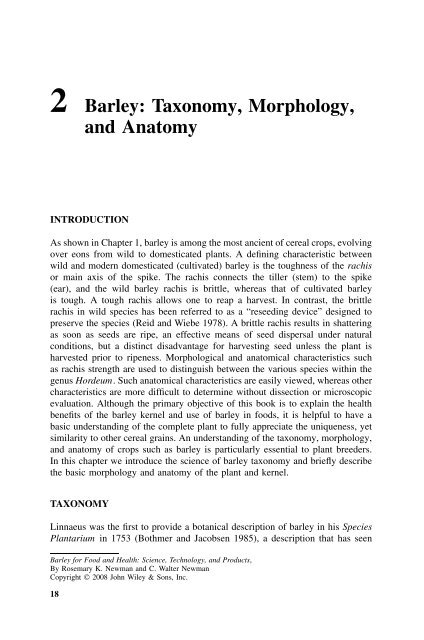Barley for Food and Health: Science, Technology, and Products
Barley for Food and Health: Science, Technology, and Products
Barley for Food and Health: Science, Technology, and Products
You also want an ePaper? Increase the reach of your titles
YUMPU automatically turns print PDFs into web optimized ePapers that Google loves.
2 <strong>Barley</strong>: Taxonomy, Morphology,<br />
<strong>and</strong> Anatomy<br />
INTRODUCTION<br />
As shown in Chapter 1, barley is among the most ancient of cereal crops, evolving<br />
over eons from wild to domesticated plants. A defining characteristic between<br />
wild <strong>and</strong> modern domesticated (cultivated) barley is the toughness of the rachis<br />
or main axis of the spike. The rachis connects the tiller (stem) to the spike<br />
(ear), <strong>and</strong> the wild barley rachis is brittle, whereas that of cultivated barley<br />
is tough. A tough rachis allows one to reap a harvest. In contrast, the brittle<br />
rachis in wild species has been referred to as a “reseeding device” designed to<br />
preserve the species (Reid <strong>and</strong> Wiebe 1978). A brittle rachis results in shattering<br />
as soon as seeds are ripe, an effective means of seed dispersal under natural<br />
conditions, but a distinct disadvantage <strong>for</strong> harvesting seed unless the plant is<br />
harvested prior to ripeness. Morphological <strong>and</strong> anatomical characteristics such<br />
as rachis strength are used to distinguish between the various species within the<br />
genus Hordeum. Such anatomical characteristics are easily viewed, whereas other<br />
characteristics are more difficult to determine without dissection or microscopic<br />
evaluation. Although the primary objective of this book is to explain the health<br />
benefits of the barley kernel <strong>and</strong> use of barley in foods, it is helpful to have a<br />
basic underst<strong>and</strong>ing of the complete plant to fully appreciate the uniqueness, yet<br />
similarity to other cereal grains. An underst<strong>and</strong>ing of the taxonomy, morphology,<br />
<strong>and</strong> anatomy of crops such as barley is particularly essential to plant breeders.<br />
In this chapter we introduce the science of barley taxonomy <strong>and</strong> briefly describe<br />
the basic morphology <strong>and</strong> anatomy of the plant <strong>and</strong> kernel.<br />
TAXONOMY<br />
Linnaeus was the first to provide a botanical description of barley in his Species<br />
Plantarium in 1753 (Bothmer <strong>and</strong> Jacobsen 1985), a description that has seen<br />
<strong>Barley</strong> <strong>for</strong> <strong>Food</strong> <strong>and</strong> <strong>Health</strong>: <strong>Science</strong>, <strong>Technology</strong>, <strong>and</strong> <strong>Products</strong>,<br />
By Rosemary K. Newman <strong>and</strong> C. Walter Newman<br />
Copyright © 2008 John Wiley & Sons, Inc.<br />
18

















